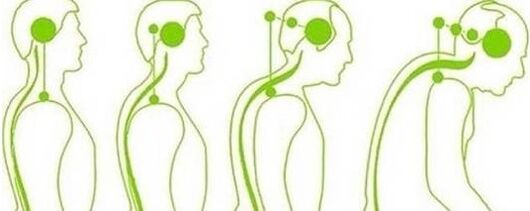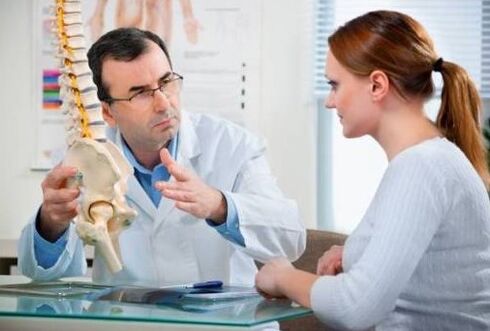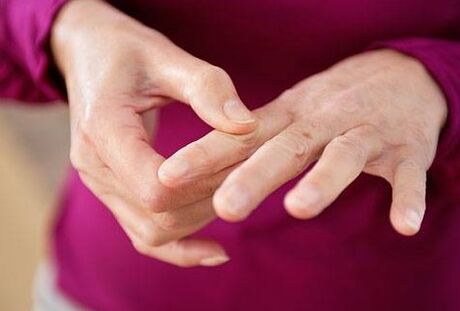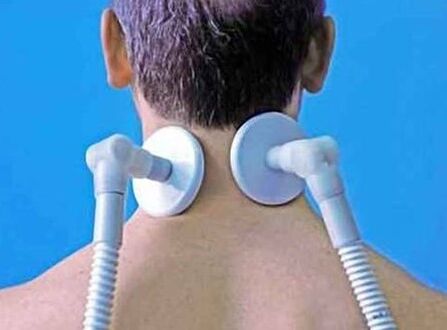Cervical osteochondrosis is most common in adults, but due to certain conditions, children can occur. When any symptoms of such a disease appear, you should contact a narrow therapist or neurologist.

Degenerative-dystrophic destruction of the spinal cervical disc characterizes cervical osteochondrosis. The progress of the disease gradually leads to damage to the intervertebral joints, adjacent vertebrae and ligaments. Many mistakenly believe that osteochondrosis is salt deposition. However, such a statement is fundamental. Salt can certainly be deposited in various joints, but with other pathologies, for example, due to the development of gout.
Thanks to the muscle system, the back of the human neck, consisting of seven vertebrae, was held. In this area, the muscles are less developed, due to long-term tension, fatigue occurs and cramps appear. In the future, the movement of the cervical vertebra becomes limited. As a result of this condition, the spinal disc is gradually destroyed, resulting in the beginning of the first stage of osteochondrosis. In the absence of treatment, the disease is constantly developing, causing all greater wounds than the spine. To prevent the development of complications, it is important to pay attention to the first pathological signs in time and take appropriate steps.
Often, people like cervical osteochondrosis are faced with people whose lifestyle provides at least physical activity and inactive work. In such people, with the biggest probability, the first feature can be real at age 25-30 years. Between children from infants to adolescence, the disease is less common, but it can also occur because of the wrong lifestyle or descendants, the annoying factors.
Stage of development of pathology and their existing symptoms
The whole process of development of the cervical spinal osteochondrosis is divided into 4 main stages, each with certain symptoms. Treatment depends entirely on the severity of the disease. For example, the first stage, premature does not require drug treatment. To improve the patient's condition, it is recommended to radically review your lifestyle - do physical training and eat properly. Features -Features -Features of this level: excessive tension from the overall -back muscles, rapid appearance of fatigue, slight, but obvious pain at the turn and head tendency. The main weakness in this case can distinguish the fact that some people attach their importance to such symptoms, so they do not immediately turn to the hospital.

Symptoms The following are the characteristics of the second osteochondrosis:
- Pain when moving the head becomes more intense and gives it regularly to the shoulders, hands, and even back;
- Pain syndrome can occur in quiet conditions;
- There are headaches that are not caused;
- Scattered attention, the level of work capacity is reduced.
All of the above symptoms cannot continue to be aware, so for the most part, at the stage of the disease, the patient seeks medical help. Strengthening the pain is due to the decrease in the distance between the intervertebral disc and the nerve infringement. Greater deterioration occurs in the third stage. In this case, the pain in the neck is always disturbing, the hand muscles become very weak, from time to time, numbness. For general symptoms, dizziness and weakness of the patient's daily friend. The cervical spine loses mobility.
Inaccessible pain in the neck, shoulders, arms, ears in the ear, complete coordination and the appearance of clear signs of other diseases indicate the beginning of the final stage of the fourth osteochondrosis. At the same time, the intervertebral disc is destroyed, and the pathological process moves further along the spine, affecting other departments. The degree of such a disease is difficult to treat, while at the discretion of the doctor, surgical intervention may be required. Therefore, with the appearance of symptoms such as: pain in the neck and crisis during head movements, hands, dizziness, nausea, headache, hands, and fatigue and problems with coordination should be a worrying signal that shows real health problems. Do not postpone a visit to a doctor, it is best to contact a therapist or immediately to a neuropathologist.
In the process of development of cervical osteochondrosis, spinal violation may occur. Sensitive disorders and different motor may appear, depending on the spine that has been suffering:
- loss of partial or complete sensitivity in the occipital region, where the neck, shoulders and arms;
- pain everywhere -the area of the neck, shoulders, arms, hands, until the tip of the finger;
- Language numbness, which is why speech disorders;
- decreased head and neck muscle tone;
- Problems with respiratory function, heart and liver pain.

The edge of a prominent vertebra can squeeze the artery where the blood enters the brain. Therefore, blood circulation in the brain is disrupted and additional symptoms arise: sharp changes in mood, insomnia, anxiety that are not caused, fear, irritation. At the same time, with blood vessel cramps, not only headaches, but also eye pain can occur. Patients often record the appearance of "flies" in the eyes, sometimes as possible.
Reason -As the development of cervical osteochondrosis
The main cause of the appearance of cervical osteochondrosis is considered to be an inactive lifestyle in conjunction with improper and unbalanced nutrition. Often, not only are people lazy to suffer from their nature, but also those whose professions forces most of the time to spend or in uncomfortable things: office workers, vehicle drivers, and others. The emergence of degenerative processes in the disc is due to violations of metabolic processes and blood circulation. Other reasons for the development of cervical osteochondrosis include:
- Excess weight that is provoked by unhealthy nutrition;
- Rheumatism, scoliosis, posture problems, flat feet;
- spinal and neck trauma;
- fixed pressure, nerve overvoltage;
- because of heredity;
- Improper development of the cervical vertebra.
Too passionate about playing sports, which means that too strong physical activity can also be a previous factor in cervical osteochondrosis. The main disease under such conditions is the disc. The second characterizes dystrophic disruption in the intervertebral disc, especially lumbar and cervical conversation. Osteochondrosis in this case is the result of a disc. In addition to heavy physical energy exceptions, with diagnosis, complex, drugs and physiotherapy treatment are required.

As a result of progressive pathology
Some of the possible complications by developing osteochondrosis of the cervical area should be distinguished:
- Hernia and spinal cord can be formed in the third stage, fourth due to the rapid development of underlying disease;
- Bone tissue growth or the formation of osteophytes - often harbingers protrusions. Osteophytes have an irritating effect on nearby muscles, improving their tone. Therefore, the pressure on the intervertebral disc increases. In addition, educated osteophytes can cause arterial narrowing;
- Spinal disc transition - decreased in the intervertebral hole leads to a decrease in height between the intervertebral disc, the risk of cervical vertebral subluxation with a sharp head turn;
- Spondylolistz or spinal disc displacement does not occur as often as complications above, however, in the case of events, even death can lead to death. Regardless, the minimum change in the intervertebral disc position with the biggest probability leads to paralysis, a more important shift - to death.
Cervical osteochondrosis always causes increased blood pressure. In addition, the transition of the underlying disease from one level to another contributes to the development of hypertension from the first to the third, where pressure exceeds the 180 mm mark. Hypertension direct treatment helps reduce the severity of the symptoms, but only temporarily. If it is not cured of osteochondrosis, it is impossible to eliminate increased blood pressure. In the case of disc damage between 4 and 5 cervical vertebra, as a complication, periarthritis occurs. It characterizes the pinch of the nerve located in the shoulder joint connection by hand. At the same time, severe pain occurs on the shoulder, has a negative effect on the mobility of the whole limbs. Also, manifestations of osteochondrosis cannot be based on the signs of heart disease, for example, angina pectoris, but thanks to the diagnostic steps, it is possible to distinguish the disease with high accuracy.
It is not possible to determine the cervical spinal osteochondrosis by palpation and as a result of visual medical examination. Based on the history collected, doctors can only assume that accurate osteochondrosis is the cause of certain symptoms. To confirm or deny such assumptions, a diagnosis is required. The optimum way today is MRI or Magnetic Resonance Therapy. This method allows you to consider all bone structures, identify the presence of intervertebral hernia, size of osteophytes and other complications of cervical osteochondrosis. Another less informative way, is the computed tomography. It allows you to establish a diagnosis, however, determining the size of the hernia, as its presence may be difficult.

Treatment of cervical osteochondrosis
Treatment of osteochondrosis of the cervical area is always complex and complex. Its duration and saturation depend on the level of development of the disease, on the individual characteristics of the patient and the presence of other diseases. Among the major groups of drugs, often prescribed in the second and subsequent stages, they should be distinguished:
- Analgesics or painkillers. The funds listed help reduce pain temporarily. With too much pain, local blockade novocaine is used.
- Nonsteroidal Anti -Anti -Steroid Medicines and Medicines -Steroids. The non -steroidal agents are safer, they have analgesic effects and can be an alternative to ordinary analgesics. If they do not relieve pain, then steroids are used.
- Antidepressants and sedatives - motherwort, tincture of valerian. Their purpose is due to two factors: if the cause of osteochondrosis is nerve overstrain or if the pain is so severe that it has a negative effect on the soul. The use of these drugs should be done under strict observation, as each drug has several contraindications and addiction.
- Musorelaxants that help relieve muscle cramps. In combination with anti -inflammatory drugs, they have analgesic effects.
- Vasransdilators contributed to increased blood circulation.
- Drugs to enhance immunity and normalization of metabolic processes are ideal for vitamins B and C.
This drug complex is a symptom treatment. Compliance with all the recommendations of the doctor and the course path set will help eliminate pain and eliminate all the manifestations of unpleasant diseases. However, therapeutic courses do not end there. When the main features are eliminated, which exacerbates the quality of life, you can take the recovery of the cervical area to minimize the risk of recurrent disease in the near future. Unfortunately, the big mistake of many people is that after losing symptoms, they consider themselves true -they are healthy and leave treatment. In this case, osteochondrosis will surely remind himself after a while.
Physiotherapy and traditional medicine
The following physiotherapy procedures are successfully used to treat cervical osteochondrosis:

- Medical Physical Education - carried out exclusively under the supervision of qualified specialists, because with serious wounds from the intervertebral disc, incorrect training can injure more tissues;
- Manual therapy - is a manual effect on a particular field of the patient's body;
- therapeutic massage;
- reflexology and, as various, acupuncture;
- Electrophoresis, balneotherapy, laser therapy, UFO, etc.
Each of the above procedures has several contraindications, which is very important for those with anamnesis of other diseases that are not related to cervical spinal osteochondrosis. The decision on the appropriateness of the use of certain methods is fixed with the attending physician. It may not be safe to take steps as your own will. For traditional medicine, you can use saberfish grass, bran. Diagram is also recommended to reduce salt intake. The approach responsible for the treatment of cervical osteochondrosis will enable it to eliminate the disease. Let this process take a lot of time, but only complex therapy will reduce the chance of developing the disease.

























